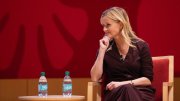Hasty Pudding Theatricals (HPT) returns to its historic home this year for its 160th production. (Since the inaugural show in 1844, the group has missed only four years, taking a hiatus during each of the two world wars.) But the theater at 10-12 Holyoke Street looks quite different than it did when students last performed there in 2005. The University has renovated the space, keeping the 1888 Georgian Revival façade but demolishing almost everything inside. The building’s modernized, and Modern, innards—designed by Leers Weinzapfel Associates of Boston—comprise 25,119 square feet of space on six stories, three above ground and three below.

Photograph © Alan Karchmer/Esto
The intimate performance space, seen from the stage, is equipped with thoroughly modern theater technology.
Because the building was surrounded on three sides by other buildings and on the fourth by the old façade, all materials had to be brought in by crane. That and the high water table (the new building requires two sump pumps, one running continuously, to keep water out) pushed up construction costs: the Corporation eventually approved spending $31 million. The University has kept the building’s name nondescript, hoping the naming rights will attract a donor.
But the New College Theatre itself is anything but nondescript: it has considerably more accouterments than the old building, where actors had to duck under support beams to get to the stage. Electrical and ventilation systems occupy the sub-subbasement; the floor above houses a laundry room, set-painting space, a prop shop, and an electrical shop. The theater itself spans two levels, with the entrance at ground level and seats sloping down to the stage a floor below. Features include a counterweight fly system and a movable thrust stage that is deeper, front to back, than the old stage. The new theater is smaller: it seats 256 to 280, instead of 350, depending on whether the production includes an orchestra and whether space is reserved for audience members with disabilities. (The entire building, except for the catwalks, is accessible.) It also features state-of-the-art technology, including audiovisual plug-ins to facilitate media coverage of HPT’s annual Man and Woman of the Year awards. Soundproofing in the upstairs dance space allows performances or practice to occur even during a show downstairs.
The upper floors hold classroom space as well: first-semester offerings included Dramatic Arts 40, “Introduction to Stage Combat,” which instructed students in the art of realistic-looking yet innocuous slaps, punches, kicks, pushes, chokes, and hair grabs. In light of the emphasis President Drew Faust is placing on the arts (see "Approaching the Arts Anew"), Jack Megan, director of the Office for the Arts at Harvard, predicts an increase in the number of professors of the practice of dramatic arts, and more outside faculty and theater professionals visiting to hold workshops. “We’re excited about the potential” the new space offers “for students to connect with faculty,” he says. “It’s not just a theater to do yet another 12 shows.”

Photograph ©Alan Karchmer/Esto
The New College Theatre fits behind and below the old Hasty Pudding venue, preserved in the façade.
There is also office space for both staff members and student groups, including HPT and the Harvard Krokodiloes and Radcliffe Pitches, two a cappella groups affiliated with the Institute of 1770, HPT’s parent organization. (Harvard bought the site from the Institute in 1986, and the building in 2000, when the group faced financial troubles. The Hasty Pudding social club, also affiliated with the Institute, has found a new home elsewhere, because its “punch” practices do not comply with College policies.)
As the first theater built for students since the Loeb Drama Center opened in 1961, the shiny new building fits well with President Faust’s goals for the arts at Harvard. Completed in June, it opened in September for the weeklong arts program that precedes freshman orientation week and for common casting (the process that allows student actors to try out for several shows in one fell swoop). Student drama and dance productions were also staged in the fall. Coming in January: a student production of Children of Eden, a musical loosely based on the Book of Genesis, with music and lyrics by Stephen Schwartz, whose other works include Wicked and Godspell. And in February, tradition returns to the theater in the form of the annual men-in-drag extravaganza, which this year is titled Fable Attraction.








